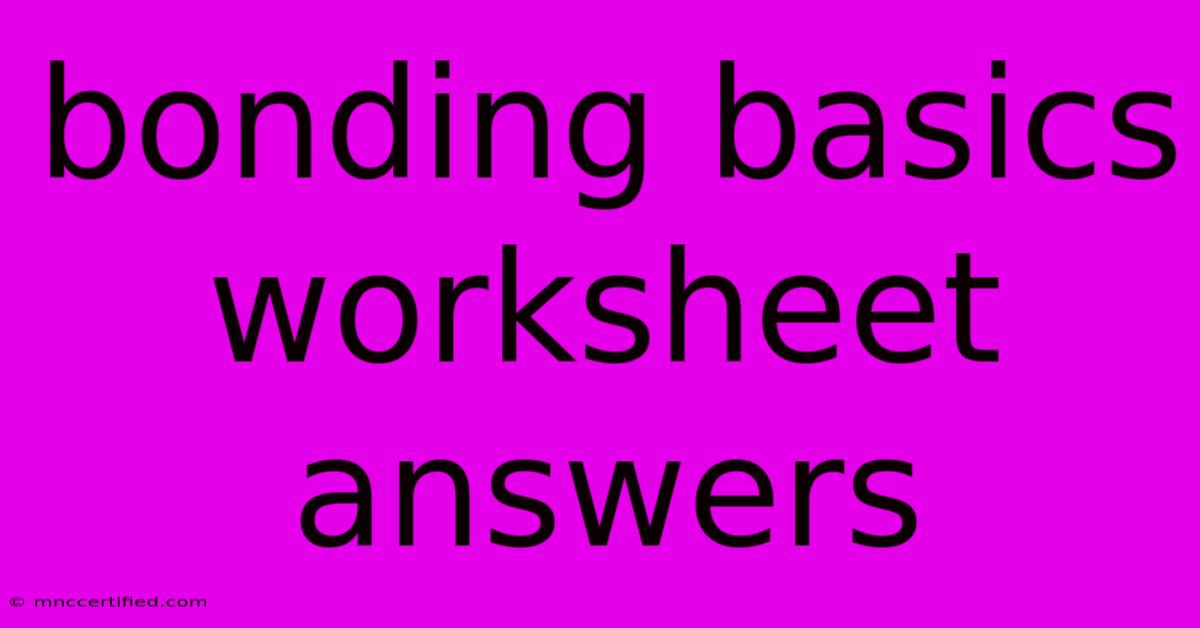Bonding Basics Worksheet Answers

Table of Contents
Bonding Basics Worksheet Answers: A Comprehensive Guide
Finding reliable answers for chemistry worksheets can be tricky. This guide provides a comprehensive approach to understanding and solving common "Bonding Basics" worksheet questions, covering key concepts and offering strategies to improve your understanding of chemical bonding. We won't just provide answers; we'll explain the why behind them, empowering you to tackle future challenges confidently.
Understanding Chemical Bonding: Key Concepts
Before diving into specific worksheet answers, let's review the fundamental principles of chemical bonding. These are crucial for accurately completing any bonding basics worksheet.
Types of Chemical Bonds:
-
Ionic Bonds: These bonds form through the electrostatic attraction between oppositely charged ions. One atom loses electrons (becoming a positive cation), and another atom gains those electrons (becoming a negative anion). This usually involves a metal and a non-metal. Example: NaCl (Sodium Chloride)
-
Covalent Bonds: These bonds involve the sharing of electrons between atoms. This typically occurs between non-metal atoms. Example: H₂O (Water)
-
Metallic Bonds: These bonds are found in metals and involve a "sea" of delocalized electrons shared among a lattice of positive metal ions. This accounts for metals' characteristic properties like conductivity and malleability.
Electronegativity and Bond Polarity:
Electronegativity is the ability of an atom to attract electrons in a chemical bond. The difference in electronegativity between two atoms determines the bond's polarity:
- Nonpolar Covalent Bonds: Electronegativity difference is very small (usually less than 0.5). Electrons are shared almost equally.
- Polar Covalent Bonds: Electronegativity difference is significant (between 0.5 and 1.7). Electrons are shared unequally, creating a partial positive (δ+) and partial negative (δ-) charge on the atoms.
- Ionic Bonds: A large electronegativity difference (greater than 1.7) results in electron transfer, forming ions.
Common Bonding Basics Worksheet Questions & Answers
While specific questions vary, common themes include:
1. Identifying Bond Types:
Question Example: Identify the type of bond (ionic, covalent, or metallic) in the following compounds: NaCl, H₂, Fe, CO₂
Answers & Explanations:
- NaCl (Sodium Chloride): Ionic bond. Sodium (Na) is a metal, and chlorine (Cl) is a non-metal. Sodium loses an electron to chlorine.
- H₂ (Hydrogen): Covalent bond. Two hydrogen atoms share electrons to achieve a stable electron configuration.
- Fe (Iron): Metallic bond. Iron is a metal, exhibiting a sea of delocalized electrons.
- CO₂ (Carbon Dioxide): Covalent bond. Carbon and oxygen are both non-metals and share electrons.
2. Drawing Lewis Dot Structures:
Question Example: Draw the Lewis dot structure for H₂O.
Answer & Explanation: Oxygen has six valence electrons, and each hydrogen has one. Oxygen shares one electron with each hydrogen, forming two single covalent bonds. The remaining four electrons on oxygen exist as two lone pairs.
3. Predicting Bond Polarity:
Question Example: Predict whether the bond in HCl is polar or nonpolar.
Answer & Explanation: Chlorine is more electronegative than hydrogen. Therefore, the bond is polar, with a partial negative charge (δ-) on chlorine and a partial positive charge (δ+) on hydrogen.
4. Naming Compounds:
Question Example: Name the compound with the formula MgCl₂.
Answer & Explanation: This is Magnesium Chloride. Magnesium (Mg) is a metal, and Chlorine (Cl) is a non-metal. The roman numeral is unnecessary as magnesium only has one common charge (+2).
Tips for Success on Bonding Basics Worksheets
- Master the basics: Understand electronegativity, valence electrons, and the octet rule.
- Practice: Work through numerous examples.
- Use resources: Refer to your textbook, online tutorials, and chemistry reference materials.
- Seek help when needed: Don't hesitate to ask your teacher or classmates for clarification.
By understanding these concepts and practicing regularly, you can confidently tackle any "Bonding Basics" worksheet and build a strong foundation in chemistry. Remember, the key is not just getting the right answers, but understanding the underlying principles. This understanding will serve you well in more advanced chemistry topics.

Thank you for visiting our website wich cover about Bonding Basics Worksheet Answers. We hope the information provided has been useful to you. Feel free to contact us if you have any questions or need further assistance. See you next time and dont miss to bookmark.
Featured Posts
-
Bail Bonds For Domestic Violence
Nov 20, 2024
-
Use The Molar Bond Enthalpy Data
Nov 20, 2024
-
What Is Bond Maintenance Shampoo
Nov 20, 2024
-
Linda Mc Mahon Leads Us Education
Nov 20, 2024
-
Automated Futures Trading Systems
Nov 20, 2024